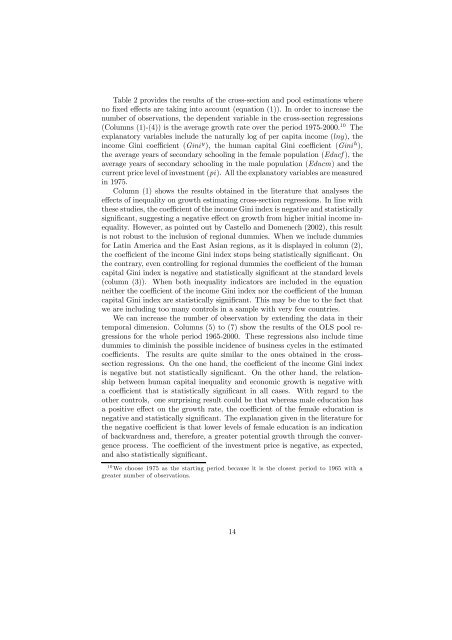Amparo Castelló-Climent, Universidad Carlos III de Madrid ... - Ivie
You also want an ePaper? Increase the reach of your titles
YUMPU automatically turns print PDFs into web optimized ePapers that Google loves.
Table 2 provi<strong>de</strong>s the results of the cross-section and pool estimations where<br />
no fixed effects are taking into account (equation (1)). In or<strong>de</strong>r to increase the<br />
number of observations, the <strong>de</strong>pen<strong>de</strong>nt variable in the cross-section regressions<br />
(Columns (1)-(4)) is the average growth rate over the period 1975-2000. 10 The<br />
explanatory variables inclu<strong>de</strong> the naturally log of per capita income (lny), the<br />
income Gini coefficient (Gini y ), the human capital Gini coefficient (Gini h ),<br />
the average years of secondary schooling in the female population (Educf ), the<br />
average years of secondary schooling in the male population (Educm) andthe<br />
current price level of investment (pi). All the explanatory variables are measured<br />
in 1975.<br />
Column (1) shows the results obtained in the literature that analyses the<br />
effectsofinequalityongrowthestimatingcross-section regressions. In line with<br />
these studies, the coefficient of the income Gini in<strong>de</strong>x is negative and statistically<br />
significant, suggesting a negative effect on growth from higher initial income inequality.<br />
However, as pointed out by Castello and Domenech (2002), this result<br />
is not robust to the inclusion of regional dummies. When we inclu<strong>de</strong> dummies<br />
for Latin America and the East Asian regions, as it is displayed in column (2),<br />
the coefficient of the income Gini in<strong>de</strong>x stops being statistically significant. On<br />
the contrary, even controlling for regional dummies the coefficient of the human<br />
capital Gini in<strong>de</strong>x is negative and statistically significant at the standard levels<br />
(column (3)). When both inequality indicators are inclu<strong>de</strong>d in the equation<br />
neither the coefficient of the income Gini in<strong>de</strong>x nor the coefficient of the human<br />
capital Gini in<strong>de</strong>x are statistically significant. This may be due to the fact that<br />
we are including too many controls in a sample with very few countries.<br />
We can increase the number of observation by extending the data in their<br />
temporal dimension. Columns (5) to (7) show the results of the OLS pool regressions<br />
for the whole period 1965-2000. These regressions also inclu<strong>de</strong> time<br />
dummies to diminish the possible inci<strong>de</strong>nce of business cycles in the estimated<br />
coefficients. The results are quite similar to the ones obtained in the crosssection<br />
regressions. On the one hand, the coefficient of the income Gini in<strong>de</strong>x<br />
is negative but not statistically significant. On the other hand, the relationship<br />
between human capital inequality and economic growth is negative with<br />
acoefficient that is statistically significant in all cases. With regard to the<br />
other controls, one surprising result could be that whereas male education has<br />
a positive effect on the growth rate, the coefficient of the female education is<br />
negative and statistically significant. The explanation given in the literature for<br />
the negative coefficient is that lower levels of female education is an indication<br />
of backwardness and, therefore, a greater potential growth through the convergenceprocess.<br />
Thecoefficient of the investment price is negative, as expected,<br />
and also statistically significant.<br />
10 We choose 1975 as the starting period because it is the closest period to 1965 with a<br />
greaternumberofobservations.<br />
14

















